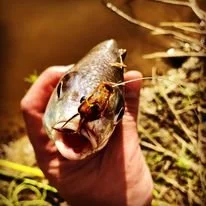They march to a different beat: The Freshwater Drum
As a fishing blogger, I've had the opportunity to catch a wide variety of fish species over the years. But there's one species that I believe is often among the most overlooked by fly anglers: the freshwater drum.
Also known as the "sheepshead," the freshwater drum is a member of the drum family (Sciaenidae) and is closely related to the red drum and black drum found in saltwater. They are found throughout much of North America, from the Great Lakes to the Gulf of Mexico, and are often caught in rivers, streams, and lakes.
The freshwater drum is overlooked for a variety of reasons. They don’t have the same flashy appearance or fighting ability of the popular game fish species. Their drab silver color, rubbery downturned mouth, and ability to thrive in rather nasty environs result in poor perception among anglers. Where the drum lacks in looks or acrobatics they more than make up for with long runs and pulling power that can rival bass or trout, making them still plenty exciting to catch.
However, the freshwater drum is a great fish to target for several reasons. For one, they are hard fighters and put up a good fight when caught on light tackle. They also make great table fare and sometimes compared to white bass or walleye in taste. They are also abundant in many freshwater systems, so they can provide a consistent catch for anglers.
Another reason why the freshwater drum is overlooked is that they are often caught as bycatch while fishing for other species. Anglers often reel in a drum and toss it back. The freshwater drum is a game fish species in many states and can be legally caught and kept.
Freshwater drum can be a fun and rewarding species to target with a fly rod. These fish are often found in rivers, streams, and lakes and can provide great sport on light tackle.
When it comes to fly fishing for freshwater drum, there are a few patterns that are known to be effective. One of the most popular patterns for drum is the Clouser Minnow. This fly imitates a small baitfish and can be fished on a sinking or floating line. The Clouser Minnow can be tied in a variety of colors to mimic the local forage, but chartreuse and white, olive and white, or brown and white are good starting options.
Another effective pattern for freshwater drum is the Wooly Bugger. This fly can imitate a variety of aquatic organisms and can be fished on a sinking or floating line. A black or olive Wooly Bugger can be a great choice, but it can also be tied in other colors to imitate local forage.
A third pattern that can be effective for freshwater drum is the Muddler Minnow. This fly imitates a variety of aquatic insects and can be fished on a floating line. A Muddler Minnow can be tied in different colors, but a natural deer hair version can be a great starting point.
A final pattern that is also known to produce is the stonefly nymph slow retrieved along creek features such as submerged islands, sunken trees, and through eddies. Black is a solid choice for it’s visibility in muddy and sandy water conditions, especially with current present.
When fly fishing for freshwater drum, it's also important to pay attention to the water conditions and the time of year. In the warmer months, drum will often be found in deeper, slower moving water. In the cooler months, they tend to move into shallower, faster moving water.
In general, freshwater drum can be caught on a variety of flies and techniques. The key is to experiment with different patterns and retrieve speeds to find what the fish are responding to. With a little practice and persistence, you'll be able to hook into some of these hard-fighting and delicious fish.
In conclusion, if you're an angler looking for a new challenge, give the freshwater drum a try. They may not be the most glamorous species, but they're a great fight on the fly.







